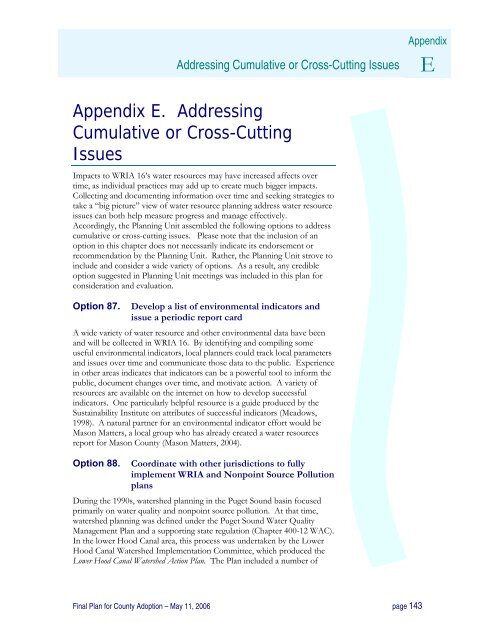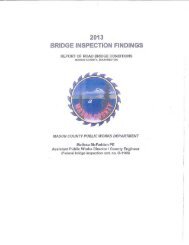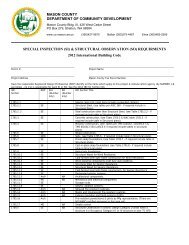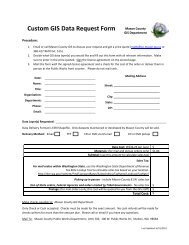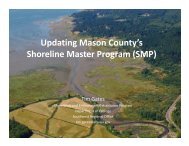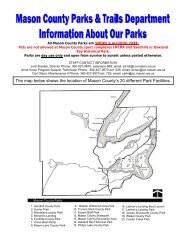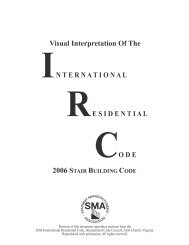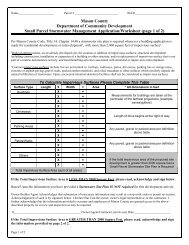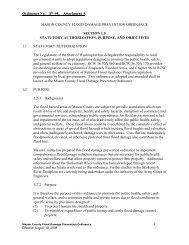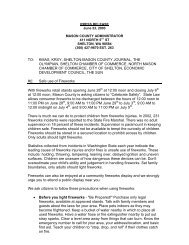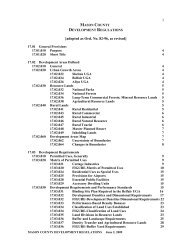Watershed Management Plan - Mason County
Watershed Management Plan - Mason County
Watershed Management Plan - Mason County
Create successful ePaper yourself
Turn your PDF publications into a flip-book with our unique Google optimized e-Paper software.
Addressing Cumulative or Cross-Cutting Issues<br />
Appendix<br />
E<br />
Appendix E. Addressing<br />
Cumulative or Cross-Cutting<br />
Issues<br />
Impacts to WRIA 16’s water resources may have increased affects over<br />
time, as individual practices may add up to create much bigger impacts.<br />
Collecting and documenting information over time and seeking strategies to<br />
take a “big picture” view of water resource planning address water resource<br />
issues can both help measure progress and manage effectively.<br />
Accordingly, the <strong>Plan</strong>ning Unit assembled the following options to address<br />
cumulative or cross-cutting issues. Please note that the inclusion of an<br />
option in this chapter does not necessarily indicate its endorsement or<br />
recommendation by the <strong>Plan</strong>ning Unit. Rather, the <strong>Plan</strong>ning Unit strove to<br />
include and consider a wide variety of options. As a result, any credible<br />
option suggested in <strong>Plan</strong>ning Unit meetings was included in this plan for<br />
consideration and evaluation.<br />
Option 87.<br />
Develop a list of environmental indicators and<br />
issue a periodic report card<br />
A wide variety of water resource and other environmental data have been<br />
and will be collected in WRIA 16. By identifying and compiling some<br />
useful environmental indicators, local planners could track local parameters<br />
and issues over time and communicate those data to the public. Experience<br />
in other areas indicates that indicators can be a powerful tool to inform the<br />
public, document changes over time, and motivate action. A variety of<br />
resources are available on the internet on how to develop successful<br />
indicators. One particularly helpful resource is a guide produced by the<br />
Sustainability Institute on attributes of successful indicators (Meadows,<br />
1998). A natural partner for an environmental indicator effort would be<br />
<strong>Mason</strong> Matters, a local group who has already created a water resources<br />
report for <strong>Mason</strong> <strong>County</strong> (<strong>Mason</strong> Matters, 2004).<br />
Option 88.<br />
Coordinate with other jurisdictions to fully<br />
implement WRIA and Nonpoint Source Pollution<br />
plans<br />
During the 1990s, watershed planning in the Puget Sound basin focused<br />
primarily on water quality and nonpoint source pollution. At that time,<br />
watershed planning was defined under the Puget Sound Water Quality<br />
<strong>Management</strong> <strong>Plan</strong> and a supporting state regulation (Chapter 400-12 WAC).<br />
In the lower Hood Canal area, this process was undertaken by the Lower<br />
Hood Canal <strong>Watershed</strong> Implementation Committee, which produced the<br />
Lower Hood Canal <strong>Watershed</strong> Action <strong>Plan</strong>. The <strong>Plan</strong> included a number of<br />
Final <strong>Plan</strong> for <strong>County</strong> Adoption – May 11, 2006 page 143


